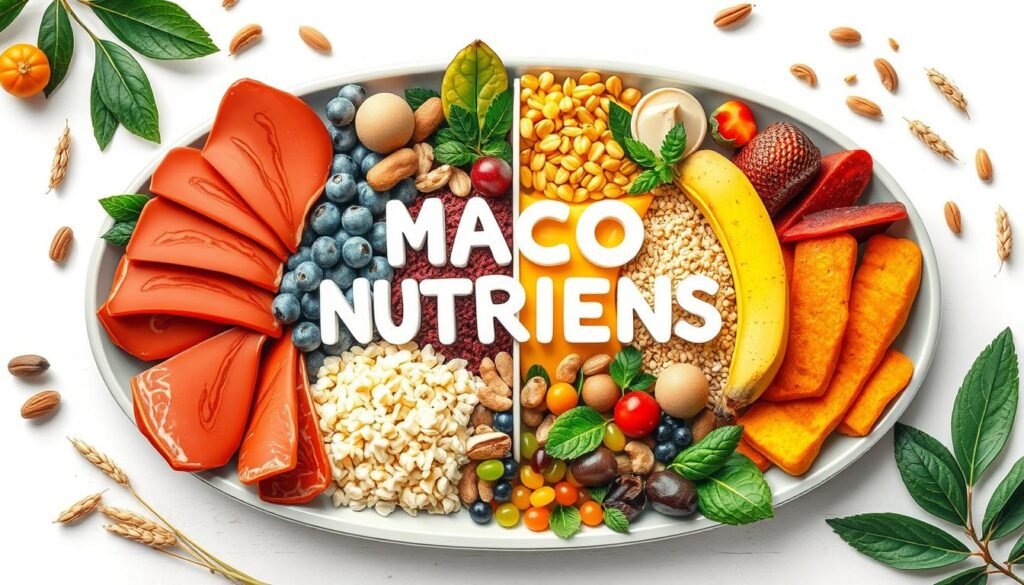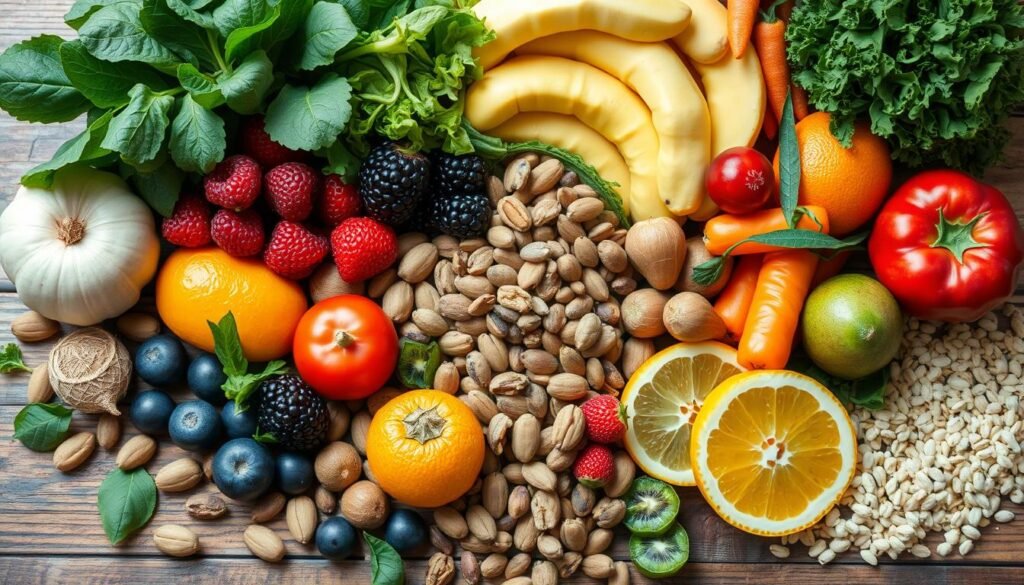Did you know over 70% of adults in the United States struggle with a healthy diet? This fact shows how vital it is to know and follow key nutritional guidelines. Eating well can increase energy, help with weight, and lower disease risks like heart disease and diabetes.
In this guide, we’ll dive into the science of nutrition. We’ll cover the basics of a healthy diet and share tips to reach your nutrition goals. Whether you want to boost your health, manage a diet condition, or make better food choices, we’ve got you covered.
Key Takeaways
- Maintaining a balanced diet is crucial for overall health and well-being.
- Understanding the science behind nutritional requirements can help you make informed choices.
- Incorporating essential food groups and macronutrients into your daily diet is key to a healthy lifestyle.
- Portion control and mindful eating techniques are important for weight management and optimal nutrition.
- Reading and understanding food labels can guide you toward making healthier purchasing decisions.
Understanding Basic Nutritional Guidelines
Good nutrition is key to a healthy life. Knowing the science behind what we need and what makes up a balanced diet is important. This knowledge helps us make better food choices and stay healthy.
The Science Behind Nutrition Requirements
Our nutritional needs change based on age, gender, how active we are, and our health. Our bodies need the right mix of macronutrients (like proteins, carbs, and fats) and micronutrients (like vitamins and minerals). Not getting enough can cause health problems, from deficiencies to serious diseases.
Key Components of a Healthy Diet
- Lean proteins: Essential for muscle growth, tissue repair, and immune function.
- Complex carbohydrates: Provide sustained energy and support digestive health.
- Healthy fats: Crucial for brain function, hormone regulation, and nutrient absorption.
- Fiber-rich fruits and vegetables: Offer a wealth of essential vitamins, minerals, and antioxidants.
- Whole grains: Deliver complex carbohydrates, fiber, and a variety of beneficial nutrients.
Adding these key elements to our diet helps us meet our dietary recommendations and nutrient requirements. This way, we can stay healthy and feel our best.
“Good nutrition is the bedrock of good health, and the foundation of a healthy life.” – Dr. Sarah Ballantyne, author and health advocate.
| Nutrient | Daily Recommended Intake | Function |
|---|---|---|
| Protein | 46-56 grams per day | Builds and repairs tissues, supports immune function |
| Carbohydrates | 130 grams per day | Provides energy, supports brain and nervous system |
| Healthy Fats | 25-35% of total daily calories | Supports heart health, hormone production, and nutrient absorption |
Building a Balanced Diet with Essential Food Groups
A balanced diet is key to good health. It must include all essential food groups. These groups offer nutrients your body needs to work well.
The five main food groups are:
- Fruits
- Vegetables
- Grains
- Proteins
- Dairy
Fruits and vegetables are packed with vitamins and minerals. Grains give you energy. Proteins help muscles grow, and dairy is rich in calcium.
To eat well, fill half your plate with fruits and veggies. Use a quarter for whole grains and the last quarter for lean proteins. Eating a variety from each group keeps you healthy.
| Food Group | Recommended Servings | Key Nutrients |
|---|---|---|
| Fruits | 1-2 cups per day | Vitamin C, fiber, antioxidants |
| Vegetables | 1-3 cups per day | Vitamins, minerals, fiber |
| Grains | 3-6 ounces per day | Complex carbohydrates, fiber |
| Proteins | 5-6 ounces per day | Amino acids, muscle-building |
| Dairy | 2-3 cups per day | Calcium, vitamin D, protein |
Eating all the essential food groups daily keeps your body healthy. It gives you the nutrients you need for well-being.

The Role of Macronutrients in Your Daily Diet
Achieving a balanced diet is key for good health. Understanding macronutrients is crucial. These are proteins, carbohydrates, and healthy fats. Each plays a vital role in a nutrient-rich diet.
Proteins: Building Blocks for Health
Proteins are essential for our cells, tissues, and organs. They help grow and repair muscles and boost our immune system. The amount of protein we need varies by age, activity level, and health.
Good sources of protein include lean meats, poultry, fish, eggs, legumes, and dairy. These foods are high in quality protein.
Carbohydrates: Energy Sources
Carbohydrates give us energy. They turn into glucose, fueling our cells. Complex carbs like whole grains, fruits, and veggies are better than simple sugars.
They offer steady energy and are full of nutrient requirements. A balanced balanced diet with the right carbs is key for energy and health.
Healthy Fats: Essential Functions
Not all fats are bad. Healthy fats, found in avocados, nuts, seeds, and oils, are vital. They support brain function, hormone production, and vitamin absorption.
These essential fats also keep our skin and hair healthy. They make us feel full and satisfied after eating.
Knowing the roles of proteins, carbs, and healthy fats helps create a balanced diet. A variety of these macronutrients is the base for a nutritious eating plan.

Micronutrients: Vitamins and Minerals for Optimal Health
Our bodies need more than just proteins, carbs, and fats. We also need a balance of micronutrients like vitamins and minerals. These tiny helpers are key to keeping us healthy and feeling our best.
Vitamins are important for many things, like keeping our immune system strong and helping us turn food into energy. Key vitamins include vitamin C, D, and the B-complex group. Minerals like calcium, iron, and magnesium help with bone strength, making red blood cells, and nerve function.
To meet your nutritional guidelines and nutrient requirements, eat a variety of foods. Fruits, veggies, whole grains, and lean proteins are full of these essential nutrients.
“A balanced diet rich in micronutrients helps support a healthy body and mind.”
By focusing on your micronutrient intake, you can boost your health and well-being. Remember, even a little bit of these nutrients can make a big difference in how well your body works.

The Importance of Micronutrients
- Support immune system function
- Aid in energy production and metabolism
- Contribute to healthy skin, hair, and nails
- Promote bone and muscle health
- Assist in the regulation of hormones and mood
Top Micronutrient-Rich Foods
- Leafy greens (spinach, kale, Swiss chard)
- Citrus fruits (oranges, grapefruit, lemons)
- Fatty fish (salmon, mackerel, sardines)
- Nuts and seeds (almonds, chia seeds, flaxseeds)
- Whole grains (quinoa, brown rice, oats)
| Micronutrient | Function | Food Sources |
|---|---|---|
| Vitamin C | Immune system support, collagen production | Citrus fruits, bell peppers, strawberries |
| Calcium | Bone and tooth health | Dairy products, leafy greens, fortified foods |
| Iron | Red blood cell formation, oxygen transport | Red meat, lentils, spinach |
Smart Portion Control Strategies
Eating well is not just about what we eat, but how much. Portion control is key to healthy eating. It helps us reach our health and weight goals without missing out on favorite foods.
Using Visual Guides for Portions
Visual guides are a great way to control portions. They help us know the right serving sizes. For instance, a protein portion is like the size of your palm. Carbohydrates should be about the size of your cupped hand.
Getting used to these guides makes it easier to manage your portions. It helps you eat right during meals.
Mindful Eating Techniques
Mindful eating also helps with portion control. Eating slowly and enjoying each bite is important. It helps you listen to your body’s hunger and fullness signals.
This way, you avoid overeating. It makes meals more balanced and satisfying.

By using these strategies, you can improve your eating habits. Portion control is not about cutting out food. It’s about finding the right amount to nourish your body and support your health.
Reading and Understanding Food Labels
In today’s world, making healthy food choices is key to our well-being. Reading food labels helps us make better choices. These labels give us important information to follow healthy diets.
Unlocking the Secrets of Nutrition Facts Panels
The nutrition facts panel is full of useful data. It shows us calories, nutrients, and vitamins. By looking at this info, we can choose foods that fit our health goals.
Deciphering Ingredient Lists
Ingredient lists tell us what’s really in our food. They help us spot allergens or unwanted additives. This way, we can pick foods that are right for us.
Health Claims and Their Implications
Food labels often have health claims to grab our attention. But, we should check these claims against the nutrition facts. This ensures the product really offers the benefits it promises.
| Food Label Component | What It Tells You | Why It’s Important |
|---|---|---|
| Nutrition Facts Panel | Detailed information on calories, macronutrients, vitamins, and minerals | Allows you to make informed choices about the nutritional value of a food |
| Ingredient List | The specific ingredients used to make the product | Helps you identify potential allergens, additives, or undesirable ingredients |
| Health Claims | Statements about the product’s potential health benefits | Requires careful consideration and cross-referencing with the nutrition facts panel |
Learning to read food labels gives us the power to choose healthier foods. This supports our health and well-being.

“Knowledge is power, and understanding food labels is the key to unlocking a healthier future.”
Meal Planning for Nutritional Success
Meal planning is a great way to keep healthy eating habits. It helps you have nutritious meals ready all the time. This guide will show you how to plan meals for the week and make a shopping list.
Weekly Meal Prep Guide
Starting a weekly meal prep routine can really help your health. Set aside a few hours on the weekend to prepare meals. You can:
- Cook and portion proteins, grains, and veggies
- Make healthy snacks like fruits, veggies, eggs, or energy bites
- Prepare salads or casseroles that can be reheated
Shopping List Essentials
Having a stocked pantry and fridge is key for meal planning. Make a list of must-have ingredients for healthy meals. Some essentials include:
- Lean proteins like chicken, fish, tofu, or beans
- Whole grains like brown rice, quinoa, or whole wheat pasta
- Fresh produce, including various veggies and fruits
- Healthy fats like olive oil, avocados, nuts, and seeds
- Low-fat dairy or plant-based alternatives
- Herbs, spices, and condiments to add flavor
Using these strategies will help you reach nutritional success and keep healthy eating habits all week.

Hydration and Its Impact on Nutrition
Keeping your body hydrated is key to a balanced diet and good health. Water helps with many body functions like absorbing nutrients, getting rid of waste, and keeping your body temperature right.
The U.S. National Academies of Sciences, Engineering, and Medicine say you should drink about 15.5 cups (3.7 liters) of water a day if you’re a man. Women should aim for 11.5 cups (2.7 liters). But, how much you need can change based on your age, how active you are, and where you live.
The Importance of Hydration in Nutrient Absorption
Drinking enough water is important for your body to use nutritional guidelines well. Water helps move nutrients around your body. It helps your cells and tissues use these nutrients. Not drinking enough water can make it hard for your body to use important vitamins and minerals.
- Water is key for body functions, helping enzymes and hormones work right.
- It helps your digestive system work better, making it easier to break down and use proteins, carbs, and fats.
- Water also helps your body use vitamins and minerals.
Tips for Staying Hydrated
Here are some ways to stay hydrated and support a balanced diet:
- Always carry a refillable water bottle and drink from it all day.
- Eat foods that are high in water, like watermelon, cucumbers, and berries.
- Try to drink less sugary drinks and caffeine, as they can make you lose water.
- Check your urine color. If it’s pale yellow or clear, you’re drinking enough water.
| Hydration Indicator | Hydration Level |
|---|---|
| Dark yellow or amber-colored urine | Dehydrated |
| Pale yellow or clear urine | Well-hydrated |
By focusing on drinking enough water, you can help your body work better. This supports your health and well-being.

“Proper hydration is the foundation for a healthy, balanced diet and overall well-being.”
Special Dietary Considerations and Restrictions
Not everyone’s nutritional needs are the same. Many people have specific dietary restrictions or requirements. This could be due to food allergies, intolerances, or personal preferences. It’s important to understand these special considerations for a balanced and healthy diet.
Common Food Allergies
Food allergies can be a big challenge. They require avoiding certain foods. The most common allergens are peanuts, tree nuts, dairy, eggs, soy, wheat, and shellfish.
For those with food allergies, it’s crucial to follow a diet without these allergens. This ensures they get all the nutrients they need.
Alternative Diet Options
Many people choose alternative diets like vegetarian, vegan, or gluten-free. These diets can offer health benefits. But, they need careful planning to meet nutritional needs.
Working with a registered dietitian can help. They can guide individuals through these dietary restrictions. This ensures a balanced and nourishing diet.
FAQ
What are the essential components of a balanced diet?
A balanced diet includes a variety of foods from different groups. This includes fruits, vegetables, whole grains, lean proteins, and healthy fats. It’s important to get the right amounts of proteins, carbs, fats, vitamins, and minerals for good health.
How do I determine the right portion sizes for my meals?
Use visual guides like your hand or a measuring cup to gauge portion sizes. Mindful eating helps too. It helps you know when you’re hungry or full, ensuring you eat the right amount of nutrients and calories.
What are the key nutrients I should focus on in my diet?
Focus on proteins, complex carbs, healthy fats, vitamins, and minerals. Proteins help build and repair tissues. Carbs give energy, and healthy fats support brain and hormone functions. Vitamins and minerals are key for bodily processes and health.
How can I read and understand food labels to make healthier choices?
Reading food labels helps you make better choices. Look at serving sizes, total calories, and macronutrients. Also, check for added sugars, sodium, and key micronutrients. This helps you pick foods that meet your nutritional goals.
What are some tips for effective meal planning and preparation?
Effective meal planning starts with a weekly menu and shopping list. Preparing meals ahead of time is also key. This ensures you have healthy options and avoids unhealthy temptations. Try batch cooking, freezing meals, and using a variety of vegetables, lean proteins, and whole grains.
How important is proper hydration for overall health and nutrition?
Proper hydration is vital for health and nutrient absorption. Drink enough water to support body functions and nutrient transport. It also helps manage hunger, supports digestion, and boosts physical and mental performance.
How can I accommodate special dietary needs or restrictions in my nutrition plan?
If you have food allergies or follow a specific diet, consult a healthcare professional or registered dietitian. They can guide you on safe substitutions and maintaining a balanced diet that meets your needs.

Hello, I’m Jimmy, founder of Jimmy Cozy Life. I’m here to help you create a home that feels warm, stylish, and balanced. With ideas for decor, celebrations, wellness, and DIY projects, my goal is to share practical tips and a bit of inspiration to make your space truly special.
Disclosure: This post contains affiliate links. If you click and make a purchase, we may receive a small commission at no extra cost to you. The content on this website was developed with assistance from AI.



